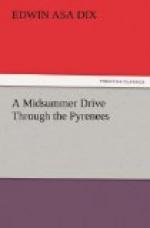Lescar was called the ville septenaire; for it had, it is said, seven churches, seven fountains, seven mills, seven woods, seven vineyards, seven gates, and seven towers on the ramparts. It is another senile hamlet now, and imagination must do all the work. Even the cathedral has been altered, and in its large, rather plain interior are few relics of its earlier state, few marks to tell of the after-despoiled tombs of Henri Quatre’s ancestry. There is a satisfying legend about this sanctuary. One of the feudal rulers had a violent hatred for some neighboring seignior, and finally secured his assassination. His hatred was thereupon followed by a remorse equally violent,—these men were violent in good as in bad, which redeems much; and in atonement he rebuilt magnificently this cathedral, which was even then an old one, and added to it a monastery as well. And to complete the story of poetic expiation, the assassin he had employed became a penitent himself; was later appointed one of the monks by his penitent patron; and ended by rising to the reverend office of abbot itself.
Southeast from Pau lies our third landmark of the past,—Coarraze. It is a longer road and a dusty one, but a village will tell off each mile, the Gave de Pau brings encouraging messages along the way, and the far Pic du Midi de Bigorre keeps inspiringly in sight. Besides the commoner trees to be met in this and other directions from Pau, are occasional orange-trees, Spanish chestnuts, aloes, acacias, and here and there a magnolia; but this region is north of much tropical verdure, even now in July, and plain beech and oak play the principal parts. Coarraze can be reached by rail also, and preferably so when haste is an object, for it is thirteen miles by the highway, while the train covers the distance within the half-hour.
This spot too had its castle and its feudal barons, subject to the court at Orthez. A tower of the castle still remains. It is of Raymond, one of these barons, that Froissart tells the legend of the familiar spirit. This obliging bogey was wont to visit his host as he lay asleep, waking him to tell him what had happened during the day in distant countries. His mode of rousing his patron was unceremonious, not to say boisterous. In his first visit, he made a terrific tumult throughout the castle, pounded the doors and casements, broke the plates in the kitchen, appalled the sleeping servants, “knocking about everything he met with in the castle, as if determined to destroy all within it.... On the following night the noises and rioting were renewed, but much louder than before; and there were such blows struck against the door and windows of the chamber of the knight that it seemed they would break them down.”
The baron could no longer desist from leaping out of his bed, and proceeding to investigate matters; and in the end the bogey and he became fast friends. In fact, the former “took such an affection to the Lord de Corasse that he came often to see him in the night-time; and when he found him sleeping, he pulled his pillow from under his head or made great noises at the door or windows; so that when the knight was awakened, he said, ‘let me sleep.’




